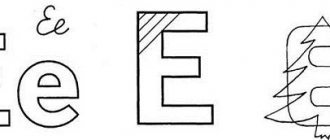Mitosis and meiosis
Cell life cycle (cell cycle)
From the moment a cell appears until its death as a result of apoptosis (programmed cell death), the cell's life cycle continues continuously.
Here and further we will use the genetic formula of a cell, where “n” is the number of chromosomes, and “c” is the number of DNA (chromatids). Let me remind you that each chromosome can contain either one DNA molecule (one chromatid) (nc) or two (n2c).
The cell cycle includes several stages: division (mitosis), postmitotic (presynthetic), synthetic, postsynthetic (premitotic) period. The last three periods constitute interphase - preparation for cell division.
Let's look at the periods of interphase in more detail:
- Postmitotic period G1 - 2n2c
- Synthetic period S - 2n4c
- Premitotic period G2 - 2n4c
Ribosomes are intensively formed, ATP and all types of RNA, enzymes are synthesized, mitochondria are divided, and the cell grows.
Lasts 6-10 hours. The most important event of this period is the duplication of DNA, as a result of which, by the end of the synthetic period, each chromosome consists of two chromatids. DNA structural proteins, histones, are actively synthesized.
Short, lasts 2-6 hours. The cell spends this time preparing for the subsequent process - cell division, proteins and ATP are synthesized, and centrioles double.
Mitosis (Greek μίτος - thread)
Mitosis is an indirect method of cell division, most common among eukaryotic organisms. It takes about 1 hour in duration. The cell prepares for mitosis during interphase by synthesizing proteins, ATP, and doubling the DNA molecule in the synthetic period.
Mitosis consists of 4 phases, which we will consider in detail below: prophase, metaphase, anaphase, telophase. Let me remind you that the cell enters mitosis with the amount of DNA already doubled (in the synthetic period). We will look at mitosis using the example of a cell with a set of chromosomes and DNA 2n4c.
- Prophase - 2n4c
- Shapeless chromatin in the nucleus begins to assemble into clearly defined structures - chromosomes - this happens due to DNA spiralization (remember my example of the association of a chromosome with a skein of thread)
- The nuclear membrane disintegrates, the chromosomes end up in the cytoplasm of the cell
- Centrioles move to the cell poles, spindle centers are formed
- Metaphase - 2n4c
- Anaphase - 4n4c
- Telophase - 2n2c
- The process of DNA despiralization begins, chromosomes disappear and become chromatin (remember the association about an untwisted skein of thread)
- The nuclear envelope appears, the nucleus is formed
- The filaments of the spindle are destroyed
DNA is maximally spiralized into chromosomes, which are located at the equator of the cell. Each chromosome consists of two chromatids connected by a centromere (kinetochore). The spindle filaments are attached to the centromeres of the chromosomes (more precisely, they are attached to the kinetochore of the centromere).
The shortest phase of mitosis. Chromosomes, consisting of two chromatids, break up into separate chromatids. The spindle threads pull the chromatids (synonymous with daughter chromosomes) to the poles of the cell.
In this phase, the chromatids (daughter chromosomes) reach the poles of the cell.
In telophase, division of the cytoplasm occurs - cytokinesis (cytotomy), as a result of which two daughter cells with a set of 2n2c are formed. In animal cells, cytokinesis is carried out by contraction of the cytoplasm, in plant cells - by the formation of a dense cell wall (which grows from the inside out).
The 2n2c daughter cells formed in telophase enter the postmitotic period. Then in the synthetic period, where DNA duplication occurs, after which each chromosome consists of two chromatids - 2n4c. A cell with a set of 2n4c enters prophase of mitosis. This closes the cell cycle.
The biological significance of mitosis is very significant:
- As a result of mitosis, daughter cells are formed - genetic copies (clones) of the mother.
- Mitosis is a universal method of asexual reproduction, regeneration and occurs the same in all eukaryotes (nuclear organisms).
- The universality of mitosis serves as further proof of the unity of the entire organic world.
Try to remember the phases of mitosis yourself and describe the events that occur during them. Pay special attention to the state of the chromosomes, emphasize how many DNA molecules (chromatids) they contain.
Meiosis
Meiosis (from the Greek μείωσις - reduction), or reduction cell division - a method of cell division in which the hereditary material in them (the number of chromosomes) is halved. Meiosis occurs during the formation of sex cells (gametes) in animals and spores in plants.
As a result of meiosis, diploid cells (2n) become haploid (n). Meiosis consists of two successive divisions, with virtually no pause between them. DNA duplication before meiosis occurs in the synthetic period of interphase (as in mitosis).
As already mentioned, meiosis consists of two divisions: meiosis I (reduction) and meiosis II (equation). The first division is called reduction (Latin reductio - reduction), since by its end the number of chromosomes is halved. The second division - equational (Latin aequatio - equalization) is very similar to mitosis.
Let's start studying the first division of meiosis. Let's take as a basis a cell with two chromosomes and a doubled (in the synthetic period of interphase) amount of DNA - 2n4c.
- Prophase of meiosis I
- Meiosis metaphase I
- Anaphase of meiosis I
- Telophase Meiosis I
In addition to the processes typical for prophase (spiralization of DNA into chromosomes, destruction of the nuclear membrane, movement of centrioles to the poles of the cell), two important processes occur in prophase of meiosis I: conjugation and crossing over.
Conjugation (lat. conjugatio - connection) - bringing homologous chromosomes closer to each other. Homologous chromosomes are those that correspond to each other in size, shape and structure. As a result of conjugation, complexes are formed consisting of two chromosomes - bivalents (Latin bi - double and valens - strong).
After conjugation, the following process becomes possible - crossing over (from the English crossing over - intersection), during which an exchange of sections occurs between homologous chromosomes.
Crossing over is the most important process during which gene recombination occurs, which creates unique material for evolution and subsequent natural selection. Crossing over results in genetic diversity in the offspring.
Bivalents (complexes of two chromosomes) line up along the equator of the cell. A fission spindle is formed, the threads of which are attached to the centromere (kinetochore) of each chromosome that makes up the bivalent.
The filaments of the spindle contract, as a result of which the bivalents break up into separate chromosomes, which are attracted to the poles of the cell. As a result, a haploid set of the future cell is formed at each pole - n2c, due to which meiosis I is called reduction division.
Cytokinesis occurs - division of the cytoplasm. Two cells with a haploid set of chromosomes are formed. A very short interphase after meiosis I is replaced by a new division - meiosis II.
Meiosis II is very similar to mitosis in all phases, so if you have forgotten something: look in the topic about mitosis. The main difference between meiosis II and meiosis I is that in anaphase of meiosis II, not chromosomes, but chromatids (daughter chromosomes) diverge to the poles of the cell.
As a result of meiosis I and meiosis II, we obtained a haploid cell - nc - from the diploid cell 2n4c. This is the essence of meiosis - the formation of haploid (sex) cells. We still have to remember the set of chromosomes and DNA in the various phases of meiosis when we study gametogenesis, as a result of which sperm and eggs are formed - sex cells (gametes).
Now we will take a cell with 4 chromosomes. Try to independently describe the phases and stages through which it will go during meiosis. Speak and comprehend the set of chromosomes in each phase.
Remember that before meiosis, DNA duplication occurs in the synthetic period. Because of this, already at the beginning of meiosis you see their increased number - 2n4c (4 chromosomes, 8 DNA molecules). I understand that you want to write 4n8c, but this is the wrong notation!) After all, our original cell is diploid (2n), and not tetraploid (4n) 
So, it's time to discuss the biological significance of meiosis:
- Maintains a constant number of chromosomes in all generations, prevents doubling of the number of chromosomes
- Thanks to crossing over, new combinations of genes arise, ensuring genetic diversity in the composition of gametes
- Offspring with new characteristics are material for evolution that undergoes natural selection
Binary fission
Mitosis and meiosis are possible only in eukaryotes, but what about prokaryotes - bacteria? They invented a slightly different method and are divided in two by binary fission. It is found not only in bacteria, but also in a number of nuclear organisms: amoeba, ciliates, green euglena.
Under favorable conditions, bacteria divide every 20 minutes. If the conditions are not so favorable, then more time is spent on growth and development, accumulation of nutrients. The intervals between divisions become longer.
Amitosis (from the Greek ἀ - particle of negation and μίτος - thread)
A method of direct cell division in which the formation of a division spindle and uniform distribution of chromosomes do not occur. Cells divide directly by constriction, the hereditary material is distributed “as one is lucky” - randomly.
Amitosis occurs in cancerous (tumor) cells, inflammatory changes, in old cells.
© Bellevich Yuri Sergeevich 2018-2020
This article was written by Yuri Sergeevich Bellevich and is his intellectual property. Copying, distribution (including by copying to other sites and resources on the Internet) or any other use of information and objects without the prior consent of the copyright holder is punishable by law. To obtain article materials and permission to use them, please contact Yuri Bellevich
.
Meiosis
The division of germ cells is called meiosis, it is accompanied by a halving of the number of chromosomes in the daughter cells. The peculiarity of this process is that it takes place in two stages, which continuously follow each other.
TOP 4 articles that are read along with this
- 1. Amitosis
- 2. ATP
- 3. Meiosis
- 4. Cell theory
The interphase between the two stages of meiotic division is so short that it is practically unnoticeable.
Rice. 2. Meiosis scheme
The biological significance of meiosis is the formation of haploid (with one set of chromosomes) germ cells in animals and spores in plants. Diploidy (a double set of chromosomes in a cell) is restored after fertilization, that is, the fusion of the maternal and paternal cells. As a result of the fusion of two gametes, a zygote with a full set of chromosomes is formed.
The decrease in the number of chromosomes during meiosis is very important, since otherwise the number of chromosomes would increase from generation to generation. Thanks to reduction division, a constant number of chromosomes is maintained.






